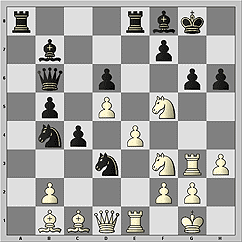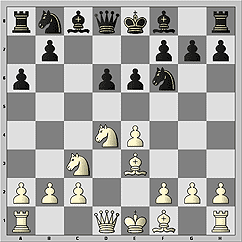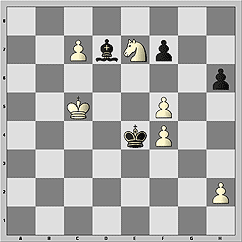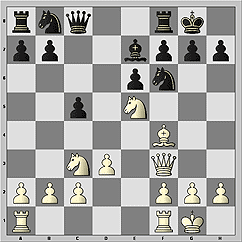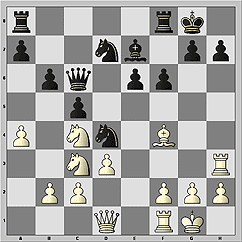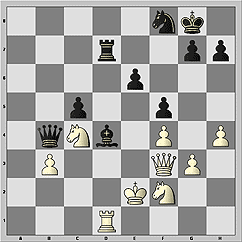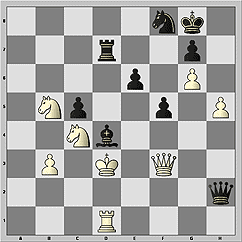 | Последние турниры |
Чемпионат России
СуперФинал

02.12.2006
Суперфинал чемпионата России проходит в Москве, в ЦДШ им. М.М.Ботвинника со 2 по 15 декабря при 12 участниках по круговой системе.
Крамник - Fritz

25.11.2006
С 25 ноября по 5 декабря в Бонне чемпион мира Владимир Крамник сыграет матч из 6 партий с программой Deep Fritz. В случае победы Крамник получит 1 миллион долларов, тем самым удвоив свой стартовый гонорар ($500000).
Мемориал Таля

5.11.2006
В Москве с 5 по 19 ноября проходил Мемориал Таля, в программе которого супертурнир 20-й категории и выдающийся по составу блицтурнир. Призовой фонд каждого состязания - 100.000 долларов.
Топалов - Крамник

23.09.2006
После того как "основное время" не выявило победителя (счет 6:6), 13 октября соперники сыграли 4 дополнительных поединка с укороченным контролем времени.
Томск. Высшая лига

2.09.2006
Со 2 по 11 сентября Томск принимает Высшую лигу чемпионата России 2006 года. В турнире участвуют 58 шахматистов - как получившие персональные приглашения, так и победившие в отборочных состязаниях.
Майнц

17.08.2006
В последние годы фестиваль в Майнце вслед за "Амбер-турниром" стал центром легких шахматных жанров. Наряду с массовыми ристалищами традиционно проходят чемпионские дуэли.
Россия - Китай

10.08.2006
С 10 по 20 августа в Китае проходит товарищеский матч сборных России и Китая. В нынешнем поединке как мужчины, так и женщины соревнуются на пяти досках по шевенингенской системе в два круга.
Все материалы
ChessPro

|
|

|
|
 |
By grandmaster
Sergey SHIPOV |
Fisticuffs of the top class! |
We had a good old custom in Russia – to fight team against team. There was no room for sloppy endearments; people scuffled zealously, till it bleeds! Usually about 50 good old friends-scrappers gathered somewhere outdoors and walloped each other with great enthusiasm. Real fun for
the spectators! It was a huge “fighting club” embracing the whole country.
Nowadays, of course, we are leaving many old traditions behind. That’s why it was even more interesting to watch the carnage the grandmasters made in the third round of the World Championship. Just like here, in Russia, say, a century ago. Blood flew like a water! No draws – this record just can’t be beaten.
In my opinion, despite different scenarios of the games the results were quite logical. The leaders increased the gap, but they have a dangerous pursuer now, the one “who is far from his best”, quoting my yesterday’s commentary.
I have a feeling, that the Indian grandmaster won this game at home. His opening preparation was better. It's not surprising! Adams's opening repertoire makes his opponents' life easier. It's possible to plant a bomb in one certain place, being absolutely sure that Adams will sooner or later be there.
Ruy Lopez C92
Vishwanathan ANAND (IND) – Michael ADAMS (ENG)
1.e4 e5 2.Nf3 Nc6 3.Bb5 a6 4.Ba4 Nf6 5.0–0 Be7 6.Re1 b5 7.Bb3 d6 8.c3 0–0 9.h3 Bb7 10.d4 Re8 11.Nbd2 Bf8 12.a4 h6 13.Bc2 exd4 14.cxd4 Nb4 15.Bb1 c5 16.d5. The opponents played a sharp line of Ruy Lopez Defense. It was extremely popular during the WC matches between Kasparov and Karpov. Since then it is considered as very dangerous for Black. This encounter only proved this verdict.
16...Nd7 17.Ra3 (the rook with a bright future!) 17...c4. Several recent games demonstrated that the matter-of-principle breakthrough 17...f5 (the way Karpov played against Kasparov) leads to a strong White's attack after 18.Nh2! with the idea of Ra3-g3. This maneuver is an integral element of White's plan.
18.axb5 axb5 19.Nd4 Qb6 20.Nf5 Ne5 (Black's main idea is to place his knight on d3) 21.Rg3. All white pieces are ready to take part in the assault. Bishops on b1 and c1 are going to ambush!
21...g6. In the game Kotronias – Fox (Cork 2005) White's attack decided in five moves: 21...Kh7 22.Nf3 Nbd3 23.Be3 Qc7 24.Bxd3 Nxd3 25.Bxh6! g6 (25...gxh6 26.Ng5+) 26.Bxf8 Rxf8 27.Qd2! and Black resigned.
22.Nf3 (White has attacked the h6 pawn; Black responds with counterattack) 22...Ned3. And here comes the bomb!!
23.Qd2!! White launches the decisive attack paying no attention to possible losses. No doubt, Vishy analyzed everything at home. The game-predecessor also saw Black rooted: 23.Be3 Qd8 24.Bd4 Bc8 25.Bxd3 Nxd3 26.Re3 Kh7 27.b3 Ra2 28.Nh2 Nxf2 29.Qf3 Nxe4 30.Nxd6 Rf2 31.Qxf2 Nxf2 32.Nxe8 Be7 33.d6 Bh4 34.Rgf3 Be6 35.Rxe6 fxe6 36.Rf8 Nxh3+ 37.Kf1 Black resigned (Konguvel – Babu, India 1999). But it's clear that this result wasn't logical...
23...Bxd5. Feeling that he has to deal with the line prepared at home, Michael is trying to find a move which was less-analyzed by his opponent. But it's impossible to escape from omnipotent Vishy. I won't even try to reconstruct all the lines analyzed by Anand's team. One hour is not enough. I believe, Black is lost. Take my word on that. After 23...Nxe1 simple 24.Nxe1 is sufficient as Black loses after 24...Ra1 25.Nxh6+ Bxh6 26.Qxh6 Rxb1 due to 27.Rxg6+ fxg6 28.Qxg6+ Kf8 (also bad is 28...Kh8 29.Qxe8+ Kg7 30.Qe7+ Kg8 31.Qe6+! etc) 29.Bh6+ Ke7 30.Bg5+ Kf8 (30...Kd7 31.Qf7+) 31.Qh6+ Kg8 32.Bf6+- Rxe1+ 33.Kh2
Black has two extra rooks and a knight, but it's time to resign. 24...Nxd5 looks interesting. The idea behind this move is to defend the king with heavy pieces, but White can ignore the black knight: 25.Nxh6+ Bxh6 26.Qxh6 and, for example after 26...Re6 27.Nf3 Nf6 28.Ng5 Rae8 29.Be3 Qc7 30.Bd4 – Black is defenseless. I can point out one more line: 23...Ra1 24.Nxh6+ Bxh6 25.Qxh6 Qxf2+ 26.Kh2 Nxe1 27.Nh4!+–.
24.Nxh6+! (perhaps, Black hoped to seize the initiative after 24.exd5 Nxe1 25.Nxe1 Ra1 and so on) 24...Bxh6 25.Qxh6. White coolly allows Black's queen invasion.
25...Qxf2+ (after 25...Nxe1 26.Nh4! the blow on g6 is irresistible) 26.Kh2 Nxe1. If 26...Bxe4 then 27. Ng5! Nxe1 28.Bxe4 Qf6 29.Nxf7! etc.; the line 26...Nxc1 27.exd5 Ncd3 28.Re6!! was no better for Black.
Michael probably thought that White had to force a draw sacrificing the rook on g6.
But Anand played 27.Nh4! (being down a rook, White is coolly building up the pressure) 27...Ned3. The path 27...Ra7 28.Nf5 Qxg3+ 29.Kxg3 gxf5 30.Qf6! (30.Qg5+ Kf8 31.Qf6 Re6) 30...Re6 31.Qd8+ Kh7 32.exf5 also leads nowhere as the retreat of the Black's rook from e6 brings the king to a scaffold.
28.Nxg6! (the town gates are broken, there is no defense) 28...Qxg3+ 29.Kxg3 fxg6 30.Qxg6+ Kf8 (or 30...Kh8 31.Bg5) 31.Qf6+ Kg8 32.Bh6. Now after 32...Ra7 White plays 33.Qg6+ winning a rook. Black resigned.
It wasn't a battle but a massacre!
The game of namesakes demonstrated that there is bad form and there is bad form!
Ruy Lopez C88
Peter SVIDLER (RUS) – Peter LEKO (HUN)
1.e4 e5 2.Nf3 Nc6 3.Bb5 a6 4.Ba4 Nf6 5.0–0 Be7 6.Re1 b5 7.Bb3 0–0. An intriguing moment! Will Svidler allow Marshall Counterattack? Do you remember the 5th game of the Brissago match? Kramnik lost this game to Leko in this very opening, and Svidler was the main analyst in Vladimir's team.
I thought that Kramnik's team had found a refutation later, but Svidler opted for… 8.h3 – It is a common way to avoid complications.
8...Bb7 9.d3 Re8 10.a4. Relatively sharp continuation. Cautious players prefer 10.a3, for example: 10...Bc5 11.Nc3 d6 12.Nd5 h6 13.c3 Ba7 14.Be3 Bxe3 15.Rxe3 Nd7 16.Ba2 Ne7 17.Nxe7+ Qxe7 18.Nh2 Nf6 19.Ng4 draw (Kramnik – Anand, Dortmund 2004).
10...h6 11.Nc3 b4 12.Nd5.
12...Na5. This move looks like a novelty although it is a standard maneuver in this pawn structure. Here is one more example of short "grandmaster draw" – 12...Bc5 13.a5 Rb8 14.Be3 Bxe3 15.fxe3 Nxd5 16.Bxd5 d6 17.Rf1 draw (Grischuk – Tkachiev, New Delhi 2000).
13.Ba2 Bc5 (it seems that a pawn sacrifice 13...b3!? should be analyzed too) 14.Bd2. It's not a bishop, it's an arrow aimed at the black knight on a5. After exchange in the center the martyr is left alone at the edge of the board.
14...Bxd5 15.Bxd5 Nxd5 16.exd5. The e5-pawn is under fire. In case of 16...d6 White seizes the initiative with 17.c3!
16...Qf6 (the option 16...c6 trying to get rid of d5 pawn, looks reasonable; for example, 17.Rxe5 Rxe5 18.Nxe5 Qf6! and the evaluation is still unclear) 17.c3! White bishop, this unwanted guest is breaking into the house of the black knight.
17...bxc3?! (it's pretty hard to explain such a hospitality; I like 17...Qb6 better. Black can play d7-d6 later) 18.Bxc3! Qb6 19.Rxe5 Bxf2+ 20.Kh1.
20...d6? It looks like a decisive mistake. Leko had to bring the Tarrasch knight back to the centre via b7. This move was possible right now or after 20...f6 21.Re4.
21.Rxe8+ Rxe8 22.b4! Nb7. I can't help crying looking at this poor knight. He would definitely like to jump to d6, but this square is occupied with Black's own pawn.
23.Ra2 Bg3 24.Re2 Rd8. Black is forced to cede the d-file fight. I wonder why did Leko choose the d8 square? This move makes the following White's maneuver even stronger.
25.Nd4! That is one more drawback of the 20...d6? move. Knight on c6 finishes Leko.
25...a5 26.Nc6 Rf8 (26...axb4 27.Bd4+–) 27.Bd4 Qa6 28.b5 Qa8 29.Re7 (it looks more like a slaughter rather than a battle of two GMs) 29...Be5 30.Nxe5 dxe5 31.Bxe5.
Black resigned. Peter scored an unbelievably easy win.
Sicialian Defence B81
Judit POLGAR (HUN) – Rustam KASIMZHANOV (UZB)
1.e4 c5 2.Nf3 d6 3.d4 cxd4 4.Nxd4 Nf6 5.Nc3 a6 6.Be3 (the move-order 6.f3 is a bit more popular) 6...e6. To avoid the ensuing complications the mighty of the Earth plays 6...Ng4 or 6...e5 here.
7.g4!? I call this aggressive plan the Hungarian Attack. The players from Hungary worked up and brought this plan into practice. We can name Sax, Hazai, Tolnai and add Polgar to this list!
7...e5 (this is the matter-of-principal answer. In other lines the position is similar to Keres attack) 8.Nf5 g6 9.g5 gxf5 10.exf5! This very move was introduced by Hungarians. White doesn't want to win a piece back, but is aiming for the quick development and attack. After 10.gxf6 f4 Black is OK.
10...d5 11.Qf3 d4 12.0–0–0 Nbd7.
13.Bxd4. Judit already won a brilliant game in this variation – 13.Bd2 dxc3 14.Bxc3 Bg7 15.Rg1 0–0 16.gxf6 Qxf6 17.Qe3! Kh8 18.f4 Qb6 19.Qg3 Qh6 20.Rd6 f6 21.Bd2 e4 22.Bc4 b5 23.Be6 Ra7 24.Rc6 – Black is a piece up, but has no useful moves – 24...a5 25.Be3 Rb7 26.Bd5 Rb8 27.Rc7 b4 28.b3 – complete zugzwang! – 28...Rb5 29.Bc6 Rxf5 30.Rxc8 Rxc8 31.Bxd7 Rcc5 32.Bxf5 Rxf5 33.Rd1 Kg8 34.Qg2 (Polgar – Anand, Dos Hermanas 1999). I think Anand doesn't like to recall this game. It's no surprise that he preferred a solid Caro-Kann defense against Polgar here. He was absolutely right!
13...exd4 14.Rxd4.
14...Bg7. Novelty. It's interesting whether it was prepared at home or born during the game. If the second is the right and it looks so as Rustam was very thoughtful in the opening, then let me ask a question: Why didn’t his team analyze this position beforehand? Earlier Black opted for 14...Bc5. For example: 15.Rd2 Qc7 16.gxf6 Nxf6 17.Bc4 Be7 18.Bb3 0–0 19.Re1 Kh8 20.Qe3 Bd8 21.Qd4 Bxf5 22.Re5 Bg6 23.Nd5 Qd6 24.f4 Rc8 25.f5 Bh5 26.Rg2 Bf3 27.Rg3 Bxd5 28.Bxd5 Bb6, and White resigned (Pulkkinen – Oll, Helsinki 1990). Of course the result of this game can be attributed to the different level of the opponents. Polgar would have easily found better options.
15.Rg1! (as usual in the Hungarian Attack White is in no hurry to win anything back. Polgar is maintaining the tension) 15...Kf8 (the line 15...Rg8 16.Bc4! doesn't look any better) 16.Qe3! White is going to send her queen to h6 with check in some lines.
16...Qe7 17.Qd2 h6 (it's impossible to recommend Black any worthy alternative) 18.gxf6 Nxf6. After 18...Bxf6 19.Nd5 Qe5 20.Nxf6 Qxf6 White isn't forced to take on d7. She is in no hurry as Black just can't develop his pieces. White can gradually build up the pressure with 21.Bc4 and so on.
19.Rd8+ Ne8.
20.Bb5! (Polgar clears the way to the centre for her rook a-tempo) 20...axb5 21.Re1 b4. After 21...Bf6 22.Rxe7 Bxe7 23.Qd4! Bxd8 24.Qxh8+ Ke7 25.Qxh6 a typical position for this system arises on the board. Black has enough material for the queen, but his are uncoordinated. Sooner or later either Black will lose one of his minor pieces or the h-pawn will become the queen.
22.Nb5? A serious mistake. It was high-time to put an end to Black’s torture with 22.Rxe8+! Kxe8 (22...Qxe8 23.Qd6+) 23.Nd5 Qxe1+ 24.Qxe1+ Kf8 25.Nc7, and White has the decisive advantage.
22...Bxb2+? Black returns a favor. After the correct 22...Be5! 23.Kb1 (23.f4 Rxa2!) 23...Kg7 White has to prove that her attack is worth sacrificed pieces. In the post-mortem I didn't manage to find such arguments. I can only point out that 24.f4 is refuted with 24...Bxf4!
23.Kxb2 (23.Kb1 was also winning) 23...Qf6+ 24.Qd4! Kg7 25.Rexe8 Rxe8 26.Rxe8 Qxd4+ 27.Nxd4. The storm subsided and Black found himself in a hopeless. The time trouble aggravated Kasimdzhanov's troubles.
27...Kf6 28.f4 b6 29.Rd8 Bb7 30.Rxa8 Bxa8 31.Kb3 Bd5+ 32.Kxb4 Bxa2 33.Kb5 Bb1.
34.c3! The last subtlety. There is no reason to allow the bishop sacrifice – 34.Kxb6 Bxc2!
34...Ke7 35.Kxb6 Kd6 36.c4 Bd3 37.c5+ Kd5 38.Nc6 Ke4 39.Ne7 Bc2 40.c6 Ba4 41.c7 Bd7 42.Kc5! The white king goes to d6, forcing the bishop out from d7.
Black resigned. Bravo, Judit!
I covered this game in Russian online. As usual I won't repeat myself to annote the game move-after-move. I'm going to draw your attention only to the key moments of this encounter. Looking at the opening, it's unclear what did the Muscovite prepare at home? Judge it yourself. White chose a modest line whereas Black achieved an advantage with WELL-KNOWN, APPROVED BY PRACTICE moves. Can we explain it? We need some first-hand information.
Sicilian Defence B52
Alexander MOROZEVICH (RUS) – Veselin TOPALOV (BUL)
1.e4 c5 2.Nf3 d6 3.Bb5+. It's quite interesting, what did Topalov prepare in the English Attack. The game against Leko revealed a serious flaw in his preparation. Did Topalov's team had enough time to patch it up? Unfortunately, Alexander wasn't curious enough.
3...Bd7 4.Bxd7+ Qxd7 5.0–0 Nf6 6.e5 dxe5 7.Nxe5 Qc8 8.Qf3 e6 9.d3 Be7 10.Nc3 0–0 11.Bf4.
11...Nfd7! (well-played; Black secures the c6 square for the queen knight) 12.Nc4. In the gamae Smeets – Karjakin (Wijk aan Zee 2005) Black emerged least equal after 12.Qg3 Nxe5 13.Bxe5 f6 14.Bxb8 Rxb8 15.Rae1 Qc6 16.Qg4 f5 17.Qe2 Rf6 18.Nb1 Rg6 19.f4 Bh4 20.g3 Bf6 21.c3 Qd5 22.Nd2 Rd8 etc.
12...Nc6 13.Rae1. With this novelty White starts a dubious maneuver. White rook should have remained on the first rank. Another path is 13.Rfe1 Nd4 14.Qd1 b5 15.Ne5 Bf6 and draw was agreed. I can’t bring myself to call this stump a "game of chess" or a "real test" for this line (Rossmann – Womacka, Eilenburg, 1984).
13...Nd4 14.Qd1 Qc6 15.a4 b6 16.Re3 f6 17.Rh3.
17...Rf7! Black knight on f8 kills all White's attacking ideas. The rook position on h3 is silly now.
18.Be3 Rd8 19.Re1 Nf8 20.b3 a6 21.Ne2 b5 22.axb5 axb5 23.Nd2 Qc7. Here the most interesting part of the game starts.
24.c4!? Nc6! (white was threatening to bring Black's advantage to nothing with the exchange on d4) 25.cxb5. White clears the square for his knight, but his pawn structure is broken into pieces.
25...Nb4 26.Qb1 (26.d4 trying to simplify the position, deserves the attention) 26...Nxd3 27.Rd1 Nb4! 28.Nc4 Nd5 29.Bd2 Qb8 30.Ba5 Rd7 31.b6 Bd8. Black managed to round white pawn up.
32.Rhd3 Nxb6 33.Bxb6 Rxd3 34.Qxd3 Bxb6. White does not have a sufficient compensation for the pawn. Morozevich's attempts to engineer some counterplay resulted in forming new weaknesses in his camp.
35.Qe3 Bc7 36.g3 Qb5 37.h4 Qc6 38.f4 (last two moves don't fit each other...) 38...Rd7 39.Re1 Bd8 40.Nc3 Be7 41.Ne4 Rd4 42.Nf2 Qd5 43.Nb6 Qb7 44.Nc4 f5! 45.Kf1 Bf6 46.Ke2 Rd7 47.Qf3 Qb4 48.Rd1 Bd4.
49.g4!? (a desperate attempt to intercept the initiative) 49...h6 50.h5 Qb8 51.Rd2 Rf7! 52.g5 hxg5 53.fxg5 Qh2 54.Kd3 Qh4 55.g6 Ra7 56.Nd1 Qg5 57.Nc3 Qg1 58.Rd1 Qh2 59.Nb5 Rd7.
60.Nxd4 Qa2! 61.Nd2 Qb2! (the black queen is doing a filigree work!) 62.Ke2 Qxd4 63.Qe3 Qd6 64.Qf3 Qh2+ 65.Ke1 Rd4 66.Qb7 Rd7 67.Qf3 Rd5 68.Nf1 Re5+ 69.Ne3 f4 70.Rd3 Qg1+ 71.Kd2 fxe3+ 72.Rxe3 Qxe3+ 73.Qxe3 Rxe3 74.Kxe3 Nd7. At his point later then he should have done so, Morozevich resigned.
Will Topalov be able to play all the 14 games “with full kit” – 7 hour-games passing three time troubles in every encounter or will he got tired? Is the energy conservation law still in force in this world or not?
Standings after Round 3: 1–2. Topalov and Anand – 2.5; 3. Svidler – 2; 4. Polgar – 1.5 (it’s really strange, but there is only one player with an even score!); 5–7. Kasimdzhanov, Adams, Morozevich – 1; 8. Leko – 0.5.
Leko’s performance is shocking. He just can’t play on a decent level through a single game. Unfortunately, a strong and usually very stable grandmaster found himself in a deep crisis.
|
|


